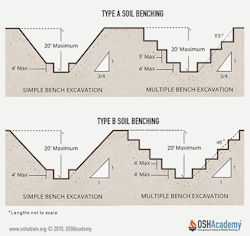Benching
There are two basic types of benching: simple and multiple. The type of soil determines the horizontal to vertical ratio of the benched side. Below are maximum allowable slope and angle requirements for Type A, B, and C soils. For more information see OSHA 1926 Subpart P App A and B .
- The bottom vertical height of the trench must not exceed 4 feet.
- Subsequent benches may be up to a maximum of 5 feet vertical in Type A soil and 4 feet in Type B soil.
- All subsequent benches must be below the maximum slope allowed for that soil type.
- A short-term (>24 hrs) maximum allowable slope of 1/2H:1V (63º) is allowed in excavations in Type A soil that are 12 feet (3.67 m) or less in depth. Short-term maximum allowable slopes for excavations greater than 12 feet (3.67 m) in depth must be 3/4H:1V (53º).
- In Type B soil, the trench excavation is permitted only in cohesive soil that sticks together when compacted.
- Type C soil is the most common type of soil in most urban and suburban areas. It may have been reworked and is not stable enough for benching as a protective system: use sloping instead.
Knowledge Check Choose the best answer for the question.
2-7. Benching may be used as a protective system in soil types?
You forgot to answer the question!

